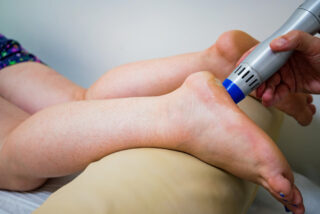
More Podiatry Foot Care Articles
What is Shockwave Therapy?

In Western medicine, we are most familiar with treatment via medication or surgery. However, there is another mode of medical treatment: physical medicine. It is less heralded in the West and used mostly for some chronic musculoskeletal conditions (MSK). For example, sometimes physical therapy (PT) may be recommended if drug therapy fails and before (or after) MSK surgery. PT is a form of physical medicine; the application of some external physical force to the body to effect some diminishing of symptoms and/or speed healing. Massage therapy is ancient. The adage RICE/rest, ice, compression, elevation is still commonly employed for a sprained, swelling ankle. At physical therapy, aside from exercises and tissue manipulation, the therapist may apply electrical stimulation or deep heat through ultrasound to the injured tissue.
“Shockwave” for chronic MSK problems was originally developed in Europe decades ago. It involves not an electric shock but pressure wave pulses of specific frequency and intensity sent through the targeted tissue. When first used in the U.S., the device was the size of a large cabinet and cost a quarter million dollars and therefore was often rented for a session and brought to the doctor’s office. The energy pulses were quite high intensity so the therapy was performed under some form of anesthesia and in one session.
Fast forward to today and the types of devices have expanded, and the size and cost of the machines have dramatically diminished. Today, the most common device in North America produces a ‘radial’ pressure wave (EPAT, by Curamedix). This type of wave is most effective with soft tissue; chronically inflamed ligaments around joints, tendons, and peripheral nerves (Morton’s Neuroma in the foot). ‘Focused’ shockwave (FSW) is similar to the original device but lower intensity. It is most effective where soft tissue is anchored to bone; chronic inflamed areas of tendon or ligament ‘insertion’ to bone (chronic plantar fasciitis, insertional Achilles/peroneal/tibial tendonitis in the foot). These devices are tabletop in size and require no anesthesia, and treatment is delivered over 3 -5 sessions lasting 10-15 minutes with intensity adjustable to the patient’s tolerance during each session.
Devices from Curamedix/Storz from Germany are the devices used in most research studies in the US, and their effectiveness in treating chronic MSK problems is impressive. Combining both EPAT and FSW brings the best results.

















